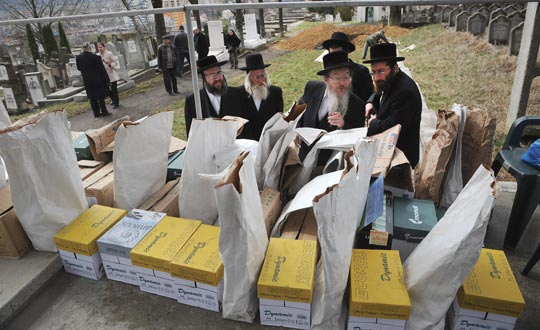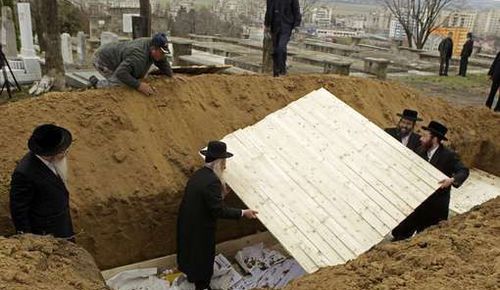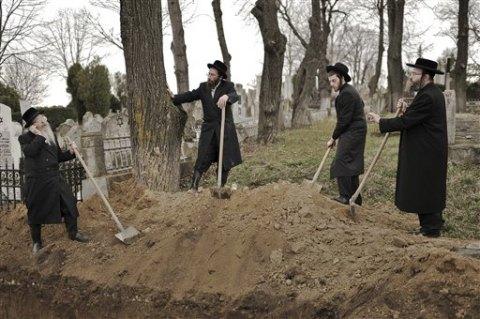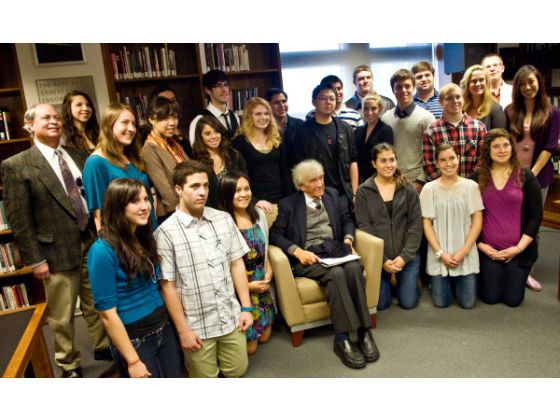Elie Wiesel Institute Wrong on Romanian Grave Claims
Sunday, April 10th, 2011
by Carolyn Yeager
But you’d never know it from reading the newspapers.
Five months after the original discovery, the Romanian mass grave case seems to have reached closure. In my Nov. 17 blog, I promised you I would keep my eye on this story. Just as I had begun to think it was a dead issue, the news broke.
Rabbis from England and the U.S. supervise the boxes and bags containing the remains of 35 to 40 persons removed from a mass grave in Iasi, Romania in Nov. 2010. [photo credit: Daniel Mihailescu]
Jewish rabbis buried the remains of 35 unidentified persons in a single grave in the Jewish cemetery in Iasi, a town in northeastern Romania. The Romanian authorities found 35 sculls in a mass grave, but the spokespersons for the Elie Wiesel National Institute for the Study of the Holocaust in Romania, which claims to have discovered the grave last year, says they can make the number at least 40 because “other remains were found.” Most news reports, however, including Haaretz, Reuters and Vos Iz Neias (an Orthodox Jewish website), reporting from Jewish sources, changed the number to 60, and even implied via confusing language that there were 100 bodies. One hundred was the estimate used by the Wiesel Institute before the grave was fully emptied.
Voice of America writes: “It is not clear how many people are represented by the remains. Estimates range from 40 to 100.
The Reuters article stated: “We gathered here to bury remains of 60 Jews murdered 70 years ago … This moment marks a duty of ours,” Aurel Vainer, head of the Federation of the Jewish Communities in Romania told Reuters.
Vos Iz Neias said: “The memorial, dedicated to about 60 victims unearthed in a forest area near the village of Popricani …” and “Quoting witnesses, the Elie Wiesel institute said more than 100 Jews—men and women, including elderly people, and children—were buried there.”
Haaretz: “The remains of dozens of Jews killed by Romanian troops during World War II have been buried …” and “In November, a Holocaust-era mass grave containing the bodies of an estimated 100 Jews was discovered in a forest …”
I guess these statements could be true if many of the victims were headless. The most accurate coverage we’ve seen comes from The Times of Malta.
Still not confirmed to be Jews
At the time of the discovery, Jewish religious authorities showed up at the site and demanded that Jewish halachic law be followed by not disturbing the bones since they believed they were Jewish bones. However, as I reported previously, the chief prosecutor in Iasi, Cornelia Prisacaru, stated plainly: “We can’t confirm that they are Jews.” And that confirmation has not come. Prisacaru also said at that time: “They could be Russian or German soldiers.” Live WWII munitions were found there in addition to human remains.
The first thing the Romanian authorities did was to close off the area, then unearth all the remains and bring them to laboratories for “forensic testing.” No results have been announced; perhaps something will be forthcoming, or perhaps nothing more can be determined. If the remains had been declared by the prosecutor’s office to be Jewish bones, the Jews would surely have announced that as loudly as possible. Since they have not, we can assume for the time being that it was not determined.
However, the Jews were convinced from the moment of discovery that they are Jewish remains, based on local witness testimony of one or two individuals, and the fact that they say some bodies were clothed in “identifiable Jewish garments.”
There is no word whatsoever from the Romanian prosecutor’s office, except that the boxes and bags of remains were turned over to the official committee of rabbis from England, United States and Romania.
Jewish rabbis preparing the grave to be covered with soil on April 4, 2011. This photo angle gives a good idea of the size of the grave.
Did the Jews win or lose?
The rabbis and Jewish media are putting the best face on it, but they were denied their demand that the bones remain where they were found so that they can build a memorial at the site. They insist these were Holocaust-related deaths which can be blamed on the Romanian Army, allied with the Nazi Party in Germany. The Jews have never failed in the past to persuade national governments to hand over the land where they believe Jews are buried, on which they then build an on-site Holocaust memorial, assuring that the area can never be explored further. This time, however, the Romanians said no, probably because there was:
- No assurance they were Jews
- No assurance they were Holocaust-related
On November 23 last year, The Committee for the Preservation of Jewish Cemeteries in Europe issued a statement in London that “this was the first time ever that a national government is openly declaring its intention to proceed in the disturbance of the graves of Holocaust victims.” All I can say is, it’s about time. Congratulations to the Romanian government.
Thus, the rabbis were forced to bury the remains in a Jewish cemetery nearby. A single large grave was dug to hold all the boxes. Since goyim don’t visit Jewish cemeteries, the propaganda value of the “murdered Jews” is destroyed. But the rabbis did hold a ceremony and made solemn pronouncements with all the dignity of which they are capable.
What if they are not Jews?
The question remains: Since the Jews insisted these were Jewish victims of a pogram, leaving them with no option but to bury them in the Jewish cemetery … what if they’re not Jewish? They may be putting non-Jewish, or what they call Goyim, bones into their Jewish ground and blessing them … a terrible desecration according to their law. I believe they had no choice because image and propaganda is more important to them than their law. Their propaganda insists on Jewish victims, and their image does not allow that they might be wrong.
Rabbis take a pause from their labors of filling in the grave after placing the physical remains inside. Do you think they really did it all themselves or is this what is called a “photo opportunity.”
Will this be the last of the Romanian mass grave story? I hope so. But if we hear more about it, we will let you know. The black-eye should go to the Elie Wiesel National Institute for the Study of the Holocaust in Romania for making exaggerated claims in the beginning, which they knew were unfounded. But you just watch—the media, and the local history (based on the Wiesel Institute), will be describing the original grave as holding 60 to 100 bodies, and anyone protesting that number will not be heard. But you can count on always getting the real story here on Elie Wiesel Cons the World website.
See original blog: Wiesel Institute in Romania says it found mass grave of Jews.
Category Featured | Tags: Tags: Cornelia Prisacaru, Elie Wiesel Natl. Inst. for the Study of the Holocaust in Romania, forensic testing, Jewish rabbis, mass grave, Romania,
Social Networks: Facebook, Twitter, Google Bookmarks, del.icio.us, StumbleUpon, Digg, Reddit, Posterous.





